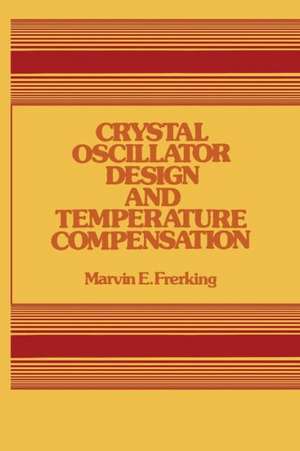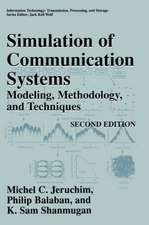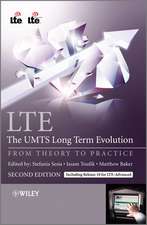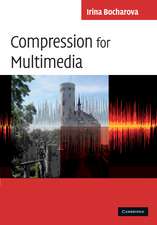Crystal Oscillator Design and Temperature Compensation
Autor Marvin Frerkingen Limba Engleză Paperback – 24 ian 2012
Preț: 385.47 lei
Nou
Puncte Express: 578
Preț estimativ în valută:
73.76€ • 77.17$ • 61.27£
73.76€ • 77.17$ • 61.27£
Carte tipărită la comandă
Livrare economică 03-17 aprilie
Preluare comenzi: 021 569.72.76
Specificații
ISBN-13: 9789401160582
ISBN-10: 9401160589
Pagini: 260
Ilustrații: XVI, 240 p.
Dimensiuni: 152 x 229 x 14 mm
Greutate: 0.35 kg
Ediția:Softcover reprint of the original 1st ed. 1978
Editura: SPRINGER NETHERLANDS
Colecția Springer
Locul publicării:Dordrecht, Netherlands
ISBN-10: 9401160589
Pagini: 260
Ilustrații: XVI, 240 p.
Dimensiuni: 152 x 229 x 14 mm
Greutate: 0.35 kg
Ediția:Softcover reprint of the original 1st ed. 1978
Editura: SPRINGER NETHERLANDS
Colecția Springer
Locul publicării:Dordrecht, Netherlands
Public țintă
ResearchCuprins
1.Introduction.- 2.Basic Oscillator Theory.- 3.Methods of Design.- 3.1.Experimental Method of Design.- 3.2.Y-Parameter Method of Design.- 3.3.Power Gain Method of Design.- 3.4.Nonlinear Modifications.- 4.Oscillator Frequency Stability.- 4.1.Temperature Effects of Frequency.- 4.2.Long-Term Frequency Drift.- 4.3.Short-Term Frequency Stability.- 5.Quartz Crystal Resonators.- 5.1.Load Capacitance.- 5.2.Pin-To-Pin Capacitance.- 5.3.Resistance.- 5.4.Rated or Test Drive Level.- 5.5.Frequency Stability.- 5.6.Finishing or Calibration Tolerance.- 5.7.Crystal Aging.- 5.8.Q and Stiffness of Crystals.- 5.9.Mechanical Overtone Crystals.- 5.10.Spurious or Unwanted Modes.- 5.11.Vibration, Shock, and Acceleration.- 5.12.Standard Military Crystals.- 5.13.Specifications and Standards.- 6.Discussion of Transistors.- 6.1.Transistor Equivalent Circuits.- 6.2.Y-Parameter Model.- 6.3.Hybrid ? Equivalent Circuit.- 6.4.Nonlinear Models.- 7.Oscillator Circuits.- 7.1.Pierce, Colpitis, and Clapp Oscillators.- 7.2.Pierce Oscillator.- 7.3.Colpitis Oscillator.- 7.4.Clapp Oscillator.- 7.5.Grounded-Base Oscillator.- 7.6.Gate Oscillators.- 7.7.Integrated-Circuit Oscillators.- 8.Preproduction Tests for Crystal Oscillators.- 9.Other Topics.- 9.1.Crystal Switches.- 9.2.Pullable Oscillators.- 9.3.Crystal Ovens.- 9.4.Squegging, Squelching, or Motorboating.- 9.5.Spurious Oscillations.- 10. Temperature Compensation.- 10.1.Analog Temperature Compensation.- 10.2.Hybrid Analog-Digital Compensation.- 10.3.Digital Temperature Compensation.- 10.4.Temperature Compensation with Microprocessors.- Appendix A Derivation of the Complex Equation for Oscillation.- Appendix B Derivation of Y-Parameter Equations for the Pierce Oscillator.- Appendix C Derivation of Y-Parameter Equations for the Grounded-Base Oscillator.-Appendix D Derivation of Approximate Equations for the Clapp Oscillator.- Appendix E Derivation of Approximate Equations for the Pierce Oscillator Analysis.- Appendix F Derivation of Approximate Equations for the Colpitts Oscillator.- Appendix G Large-Signal Transistor Parameters.- Appendix H Large-Signal Transistor Parameters with Emitter Degeneration.- Appendix I Nonlinear Analysis of the Colpitts Oscillator Based on the Principle of Harmonic Balance.- Appendix J Mathematical Development of the Sideband Level versus Phase Deviation Equation.- Appendix K Derivation of Crystal Equations.- Appendix L Sample Crystal Specification.










